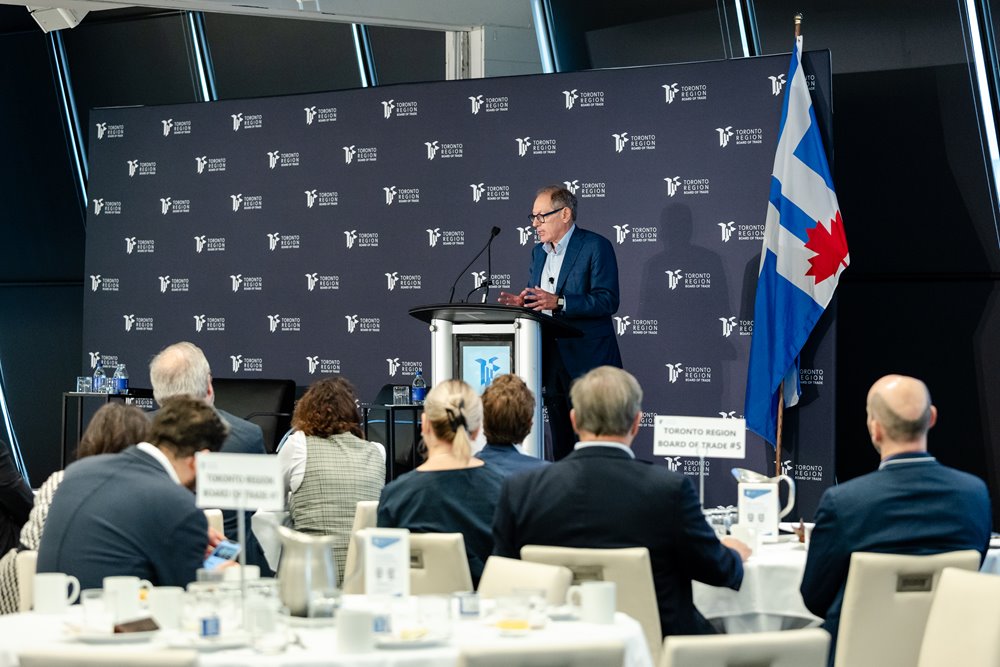
This article originally appeared in The Globe & Mail.
Despite some reprieve, U.S. President Donald Trump imposed a damaging array of tariffs on Canadian products this week; seemingly still committed to employing economic “force” against Canada. Now is the time for a national project to build back the economic strength needed, not only to withstand what could be a prolonged siege, but the upheaval of the entire global trade system.
The question is whether political leaders – and Canadians – are truly ready for the step changes required to meet the moment. Elbows up! Canada First! Less than two weeks into the 45th federal election campaign, the answer remains unclear.
As President Trump rewrites the rules for American advantage, we need to move beyond our cautious, comfortable, slow-growth model of the last 40 years and quickly invent a high-growth economy fit for the 21st century. No more business as usual.
Canada will need significant reforms if we are to build that high-growth, more competitive model. It starts with ensuring we can root, retain and reshore businesses in Canada.
While our GDP growth ranks among the highest in the G7, that’s almost exclusively due to population growth. Canada’s actual output – GDP per person – is among the lowest. We’re growing the number of people consuming the pie faster than we’re growing the pie itself. It’s no wonder cost of living is a challenge.
So, where have we gone wrong?
We’ve steadily lost our competitiveness. We were once rolling in natural resources wealth, and massive investment inflows. But, for the past four decades, we’ve gradually run down this vast inheritance and haven’t replaced it. Our focus has been consumption, not production.
We have a fragmented patchwork of overly burdensome rules and regulations and a tax environment that doesn’t seek to keep capital here. Many businesses today believe we’ve built an environment that’s, at best, indifferent to business success.
By contrast, the U.S. has doubled down on becoming a magnet for capital, talent and entrepreneurship. As Statistics Canada shows, over the past several years, the gap between outbound investment from Canadian businesses and institutions to the U.S. versus inbound to Canada has grown to nearly $500-billion. We are financing U.S. growth and productivity with Canadian dollars.
The result: more investment dollars, top talent and companies go south.
A stronger Canada must start with this election. We must systemically – not piecemeal – address our long-standing economic obstacles.
Here are four key areas to tackle.
First, regulation needs to actively encourage growth, not exclusively manage risk. That means overhauling our outdated, bloated regulatory framework to simplify compliance and speed up approvals. Take Liberal Leader Mark Carney’s just-released housing plan, which aims to build 500,000 homes annually. All sectors responsible for housing may not agree with everything proposed, but there are many ideas included to simplify regulation that are multi-pronged and connect together in a way previous policies have not. We need to see more policies that come together as a full-scale blitz on our competitiveness challenges across the economy.
Further, across all industries, adopting best-in-class international standards, as opposed to homegrown standards, should be table stakes for attracting investment, ensuring Canadian firms can compete globally.
Second, Canada needs a globally competitive tax system that attracts capital and rewards growth. That includes creating a more predictable environment for entrepreneurs, innovators and investors to build and scale companies here. Conservative Leader Pierre Poilievre’s proposal to go beyond merely rolling back recent capital gains tax increases touches directly on a real and growing concern: capital outflows. Is it a complete solution? No. But it’s a real shift in the right direction. Reversing the flow of Canadian investment capital abroad must become a national priority.
Third, it’s a promising signal that in recent weeks the federal government and provinces have been deep in discussion over a national plan to fast-track eliminating our interprovincial trade barriers; adopting mirror legislation that would recognize each other’s differing regulatory requirements. After 157 years, it’s time to achieve a single market to unleash Canada’s economic potential.
Fourth, both parties are emphasizing infrastructure. We need to double down on building infrastructure, specifically to move people, goods and resources. The next step is getting it done without the now requisite foot-dragging: fast-track regulatory and tax measures to speed up and lower project costs.
President Trump’s tariffs only compound our issues. A looming drop in Canadian GDP represents permanent economic loss, as future growth compounds from a smaller base. These costs aren’t hypothetical. We’re already seeing investments frozen, companies fleeing south and export earnings eroded.
Business needs bold action to supercharge Canada’s competitiveness. Two questions remain: will politicians offer truly transformative ideas, and do Canadians have the ambition to see it through?
-

Giles Gherson
President and Chief Executive Officer, Toronto Region Board of Trade
Giles Gherson serves as the President and Chief Executive Officer of the Toronto Region Board of Trade, among North America's largest and most influential business organizations. In this role, Giles leads the Board's initiatives to strengthen and sustain business growth and competitiveness across the Toronto region, one of the fastest-growing metropolitan centres in North America.
Giles is dedicated to addressing the region’s most pressing challenges, including the widening productivity gap, the ongoing congestion crisis, and barriers to greater regional investment. At the same time, he champions Toronto’s vibrant growth and its role as a global leader in AI, data hubs and the diversity of its business sector. Under his leadership, the Board established the CEO-led Business Council of Toronto to tackle critical issues, with a strategic focus on Advanced Manufacturing, Climate and Energy Transition, the GTA West Economic Gateway, and the Financial Services sector.
Prior to joining the Board in 2022, Giles spent over 25 years in the private and public sector in progressively senior roles. He spent 15 years with the Province of Ontario, where he held multiple influential Deputy Minister roles – most extensively and recently as Deputy Minister, Economic Development. Previously, Giles has led the government’s economic growth and competitiveness policy, overseen the recent creation of two new agencies, Invest Ontario and IP Ontario, and worked to attract a wave of technology and manufacturing investments, including the retooling of the province’s auto sector for next generation battery electric vehicles. He currently sits on Ontario’s Advanced Manufacturing Council, working to boost the long-term competitiveness and resilience of this sector by attracting key investments and creating opportunities for businesses across the province.
Prior to his role in government, Giles worked as editor-in-chief of the Toronto Star, political editor of the National Post and editor of the Globe and Mail’s Report on Business. Giles is the immediate past President of the Board of Directors at the Institute of Public Administration of Canada, the country’s leading professional organization supporting excellence in the public sector.

